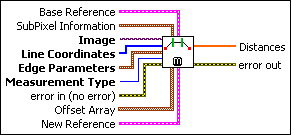IMAQ Line Gauge VI
Owning Palette: CaliperInstalled With: NI Vision Development ModuleMeasures the distance between selected edges with high-precision subpixel accuracy. You can use different measurement modes with this VI, such as measuring distances between points and edges and vice versa. This VI also can step and repeat its measurements across the image. Depending on the type of the measurement, this VI first determines the relevant edges in the image before computing the distances.




 |
Base Reference is the base coordinate system. This cluster contains the following elements:
|
||||||||||
 |
SubPixel Information is a cluster containing the following parameters for subpixel analysis:
|
||||||||||
 |
Image is a reference to the source image. |
||||||||||
 |
Line Coordinates is an array specifying the pixel coordinates that form the end points of the line. |
||||||||||
 |
Edge Parameters is a cluster defining the characteristics of the filter used to detect the edges. This cluster consists of the following parameters:
|
||||||||||
 |
Measurement Type specifies the type of measurement to perform. The following values are valid:
|
||||||||||
 |
error in (no error) describes the error status before this VI or function runs. The default is no error. If an error occurred before this VI or function runs, the VI or function passes the error in value to error out. This VI or function runs normally only if no error occurred before this VI or function runs. If an error occurs while this VI or function runs, it runs normally and sets its own error status in error out. Use the Simple Error Handler or General Error Handler VIs to display the description of the error code. Use error in and error out to check errors and to specify execution order by wiring error out from one node to error in of the next node.
|
||||||||||
 |
Offset Array is an array of point clusters that specifies the shift in the start and end points of the pixel coordinates. The Offset Array is used for repeating the measurement across the image. |
||||||||||
 |
New Reference is the new coordinate system. This cluster contains the following elements:
|
||||||||||
 |
Distances is an array containing the measured distances. |
||||||||||
 |
error out contains error information. If error in indicates that an error occurred before this VI or function ran, error out contains the same error information. Otherwise, it describes the error status that this VI or function produces. Right-click the error out indicator on the front panel and select Explain Error from the shortcut menu for more information about the error.
|








